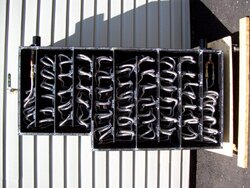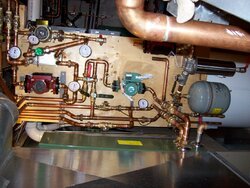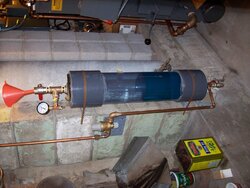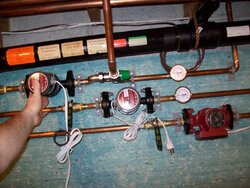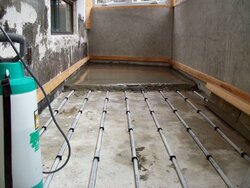Thank you – glad I found this forum – much to be learned and shared from/with my fellow wood burners.
I am contacting AHS today for an updated manual – mine only mentions piping down to the floor.
As it is in my basement and I have heard many utterings about puff-backs I am somewhat paranoid about
the possibility of flame travelling down that air intake in search of air. ONCE is too many times.
The cold air vent is 5” galv 28 ga round duct, running 7 feet between the joints above the boiler
insulated with ½” foil. Then it crosses over the boiler (insulated) downward on a 45 degree angle,
then goes down (UNinsulated) to a 5 gallon steel pail directly behind the cyclone.
I will pipe the boiler air intake outward and downward (at about 3” per foot) for 2 feet then elbow
straight down into the pail beside the fresh air pipe. These pipes remain unconnected about 4 inches
from the bottom of the pail. I have installed a sheet metal divider in the pail 8 inches tall from the bottom.
So the effect (in theory) of this is to bring in fresh air, contain it and keep the pipes physically separated.
Fresh air comes in, fills the pail and is sucked up by the air intake on the other side of the divider.
Also I am installing a 5” round horizontal fire damper just above the pail on the air intake.
Overkill, maybe – fire damper is $35.
Also – my manual makes no mention what the high/low aquastat that came with the boiler does, nor is
there any mention of the start/run switch. Although I am fairly sure I know what these do, I would prefer
they just spell it out, just in case I am missing any finer points.
My HVAC consulting guy (a contractor I pay for info & guidance) tells me I should have insulated smoke pipe
(boiler to chimney) as my clearances are closer to 14 inches. Looking into that today.
I have heated with wood all my life (25 yrs) – but with a forced air wood furnace. It was in the house when I
bought it but horribly inefficient, poorly setup, and poor ducting. Installed larger duct, a 2 speed fan, and designed
my own controls using 2 thermostats, auto-switching between them based on motor speed. The thought being
one setting for flame burn, another setting for non-flame, less vigorous burning during charcoal stage. Went from
10+ bush cords in the first year, to 3 -4 bush cords and an 80 degree house (my wife thinks that’s still a little cool).
But the old wood furnace is over 30 years old – decided to replace it before it fails. WG stood out for efficiency
and ease of cleaning which translates into less work cutting wood, less dismantling & reassembling.
I have a main loop (with Taco variable speed circ) with 10 zones, all with separate
circulators, doing baseboards, in-floor, fan coils , 2nd building (garage) with fan coil, DHW, retro
under-wood sub floor heating, towel racks, bath tub warmers, a 6 port manifold & relay panel for
small add-ons (not plumbed yet), and a filter zone. Doing all design & work myself.
Also, designed my own chiller, valves off of the main fan coil and uses cold clean sump water (I pump
8500 gallons of 48 degree water out of my basement every day) to cool the glycol in the closed fan coil loop.
Running glycol in the whole system. Also designed my own – super slick – glycol make-up.
I have an S-10 pickup, a Stihl 026, a chopping maul and some wedges. My wife and I spend 3 - 4 days
each fall in the bush cutting, splitting, hauling from live standing trees. I cut mainly hickory, oak, maple
and let dry in a rack, 2 years ahead – hopefully not going to be a problem with the WG.
I have allowed space for 60 gallon storage, but starting off without that – AHS says it is not necessary.
I will try it for the first year and see how that goes.
My dog??????
Maybe you would do me the kindness of a note with the same info about your system.
Is your garage attached to the house? Are you storing?
I don’t have many pics but here are a couple of past work in progress.
§
